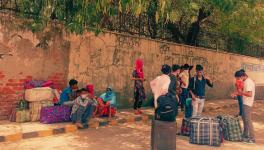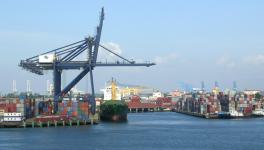Economic Revival? Winds of ‘Change’ yet to Reach Small Retailers
Representational use only.
Kolkata: A dog-weary Dulal Modak, 38, dropped two wicker baskets full of small crabs he has been ferrying since 6.30 a.m on the footpath in front of a tea shop off Rash Behari Avenue in the metropolis.
It has been a tough day. Buyers have been few and far between and the endless trudging through the city’s streets under a tireless sun, has left his throat parched dry.
Modak has been taking the train every day from Kazipara near Barasat, some 37 km from Kolkata, to sell his ‘live food’ on the streets of the megapolis, ever since he lost his job in an engineering workshop on the outskirts of the city during the lockdown that followed the second wave of COVID-19 pandemic in May-June this year.
Traders like Modak who operate below the National Income statistics radar are estimated to account for 40% of the informal sector in the city, according to a study published by IIM, Calcutta in 2016.
What is worrying researchers is that the sector, which makes for about four-fifths of India’s employment by some estimates, are losing jobs or witnessing incomes being slashed as the effects of the prolonged global pandemic takes its toll on the poor.
“The cascading effect of demonetisation five years back and the two COVID lockdowns in two years has been devastating for the informal sectors, whose ability to transact business has been badly hit… as a result employment, quality of jobs and incomes have fallen drastically,” said Pronab Sen, noted economist and former chairman of the National Statistical Commission.
An International Labour Organisation study published last year forecast that about 40% of Indians working in the informal sector may get pushed deeper into poverty, due to the pandemic as they lose jobs or earn significantly less.
Modak used to earn Rs 14,000 a month as a trained fitter in the workshop where he worked. That income has come down to about Rs 8,000-9,000 a month now as a ‘ferry-wala’ (mobile salesman). “Heavy rains mean less sales, lockdown on train services means no income… but still it’s a living,” he said with a wry grin.
Sen pointed out that unemployment, which used to be under 3% in 2011-12 and about 6% in 2017-18, is now near 8%.
According to Centre for Monitoring Indian Economy data, the 30-day moving average unemployment rate for India as on November 2 stood at 7.57%, which while lower than the 11.84% in May this year, remains at a worrying high.
The unemployment rate for most Eastern states, too, remained staggeringly high. Bihar reported a 13.9% unemployment rate, and Jharkhand 18.1% for the 30-day average on November 2. Bengal’s unemployment figure stood at 5.6% for the same period.
Despite the grim picture, many see a ray of hope in the days ahead.
“We see the economy lifting slowly but surely… credit offtake by small businesses has been going up,” said Chandra Shekhar Ghosh, Managing Director & CEO of Kolkata-based Bandhan Bank.
Data released by the Reserve Bank of India showed non-food credit offtake or lending rose by 6.8% in the 12-month period ending September 2021, compared with 5.1% in the corresponding period last year.
Bengal’s employment figures actually improved during the just gone by festive month of October by almost a percentage. Ghosh said small businesses and micro enterprises were possibly more nimble-footed despite the serious problems they had been facing.
“Large shops had their loans sanctioned long back, but took the money only a month before Durga Puja to buy stocks to sell during the festivities. Micro-retailers like say a ‘phuchka wala’ (savoury snack seller) availed their loan money just 10 days before the festivals began,” said the banker, who has long specialised in MSME finance.
A recent British Council study pegged Bengal’s creative economy around Durga Puja at Rs 32,377 crore, with retail accounting for a whopping Rs 27,364 crore. Other studies indicate a 100% jump in retail sales during the month compared with normal months.
However, economists worry that without long-term improvement in the fortunes of the informal sector, India’s economic recovery will be held up.
“Till the small guy earns better incomes, overall demand will not go up. Corporate India has been reporting better sales with their merchandise replacing products from the small and micro sectors.
“But, this is replacement sales and it will hit a ceiling as the overall demand in the country, which was depressed over the last few years, is not going up,” pointed out Sen.
Siddhartha Sanyal, chief economist at Bandhan Bank and former chief India economist at Barclays Bank agreed: “The informal sector has been facing multiple threats, which has been difficult for them to negotiate.”
Small and micro businesses lost out in a big way when demonetisation happened as they mostly transacted in cash, which was in short supply. Goods and Services Tax rules, which were introduced less than a year after demonetisation, came as a double whammy as it raised compliance costs, while COVID lockdowns with their stifling impact on sales and labour availability, proved to be the proverbial last straw on the camel’s back.
Many small businesses like the one where Modak had worked shut shop, as they did not have the deep pockets needed to accept losses, pay back loans or fixed costs during the turbulent times.
Arindam Saha, proprietor of Artistry, an interior decoration firm, said, “We faced nine long months without any payment recoveries during this pandemic, had to pay 15 workers’ salaries from personal savings… business has recovered to about 60% of pre-COVID days. Let us hope that things get better.”
Regulatory uncertainty makes things tougher for the small businessman. Flip-flops on allowing firecrackers during Diwali was cited as one such uncertainty, which has hit tens of thousands of small businesses and retailers.
“To top it all, the cost curve is stiffening. Global prices of energy and metals are going up,” pointed out Sanyal.
In the midst of all this, people like Modak and Saha have to stay afloat. “They (crabs) are still alive. And, I sell at rates lower than the market,” said Modak, as he eyed a potential customer at the tea shop, while palming his own tea served in an earthen ‘bhar’ (cup).
Some among the late morning office goers inspected his wares, and tried to drive a hard bargain. Others just nodded and moved on. Modak and the economy must wait for the winds of change.
Get the latest reports & analysis with people's perspective on Protests, movements & deep analytical videos, discussions of the current affairs in your Telegram app. Subscribe to NewsClick's Telegram channel & get Real-Time updates on stories, as they get published on our website.
























